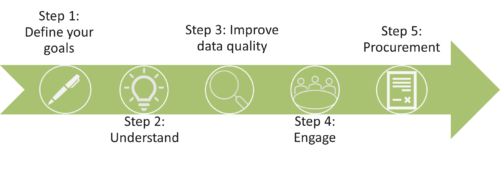Scope 3 emissions, on average, account for 75% of a company’s emissions. Within scope 3, category 1, Purchased Goods and Services, can account for up to 80% of scope 3 emissions and this category includes all products and services that a business may purchase from suppliers. So, with an increasing number of companies setting scope 3 reduction targets, strategies to reduce emissions associated with suppliers are clearly critical.
Corporate Citizenship recently developed a five-step supplier engagement strategy with a leading med-tech company, whose ambitious scope 3 reduction target relied on a significant level of decrease from its suppliers, due to these emissions dominating its scope 3 footprint. The supplier engagement strategy thus acted as a roadmap both to help cut supply chain emissions and to ensure the company could achieve Science Based Targets Initiative (SBTi)-aligned scope 3 targets.

Following these five steps, you can also design and implement an effective strategy to encourage, engage and measure reductions in your emissions associated with your supply chain.
Step 1: Define your goals
In the first step, you need to consider what you want to achieve.
Outline your goals and success measures to ensure the overarching goal is clear, measurable and achievable.
Develop clear KPIs that your success can be measured against.
Step 2: Understand
The next step is to understand your supply chain.
You should identify which suppliers are the top emitters, which suppliers are critical to your operations. You should also consider which suppliers you have a limited influence on due to low or infrequent spending. You may choose to include additional criteria when categorising, including the procurement of rare or high-risk materials.
Using these identifiers, suppliers can be categorised into three levels of engagement for a more staggered approach. These categories will define when steps 3 to 5 are implemented for each supplier.
Step 3: Improve data quality
Spend-based estimations are often the default for scope 3 , but moving beyond this is vital to measuring the success of your strategy. Aim to move towards collecting supplier-specific emissions and/or product-specific emissions data from your suppliers, for a more accurate footprint that will reflect emissions reduction achievements.
Step 4: Encourage changes from existing suppliers
Encouraging or requiring existing suppliers to calculate emissions, set reduction targets and outline how to meet those targets, will help to ensure your supply chain aligns with your own environmental strategy. To ease this process, there are several supplier platforms that can facilitate this data collection and management for you.
Step 5: Procurement
Requiring data collection and emissions reduction targets/initiatives as a part of your procurement process, will ensure any new suppliers are on the same journey as your existing suppliers.
Outcome
The outcome should be a comprehensive strategy covering improvements in data from suppliers, encouraged/required emissions strategies, and procurement changes across three levels of suppliers, which will, in turn, support a reduction in supply chain emissions.
According to the 2022 stocktake of global corporate net zero objectives from the Net Zero Tracker initiative, most publicly traded companies have a net zero target in place, yet the majority are not meeting the reporting protocols. When it comes to scope 3 emissions specifically, the gap between ambition and activity is concerning, with only 38% of companies claiming to cover all value-chain emissions.
Managing scope 3 emissions presents a huge challenge, with so much falling outside direct control, but the approach outlined here can provide tangible actions that can translate into quantifiable reductions for your footprint.


